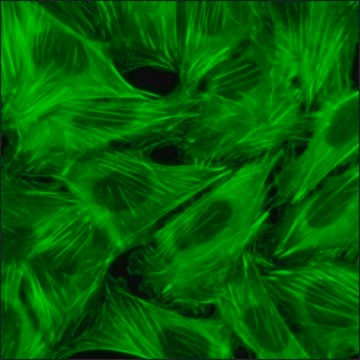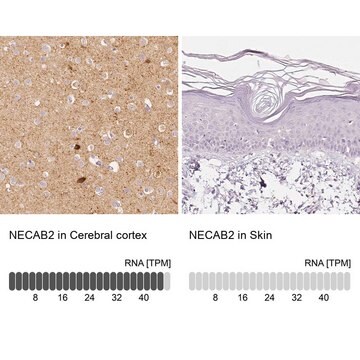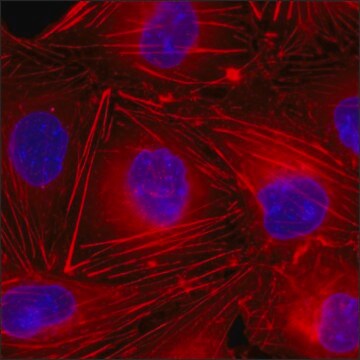CLL1037
U2OS GFP-ACTB RFP-TUBA1B
human female bone (Disease source: Osteosarcoma)
Faça loginpara ver os preços organizacionais e de contrato
About This Item
Código UNSPSC:
41106514
NACRES:
NA.81
Produtos recomendados
product name
U2OS GFP-ACTB RFP-TUBA1B,
fonte biológica
human female bone (Source Disease: Osteosarcoma)
temperatura de armazenamento
−196°C
Informações sobre genes
human ... ACTB(60) , TUBA1B(10376)
Descrição geral
This product was derived from ATCC Cat. No. HTB-96.
U2OS GFP-ACTB RFP-TUBA1B are osteosarcoma, epithelial cells, from a human caucasian female (aged 15 years), with GFP-tagged and RFP-tagged modifications.
U2OS GFP-ACTB RFP-TUBA1B are osteosarcoma, epithelial cells, from a human caucasian female (aged 15 years), with GFP-tagged and RFP-tagged modifications.
Aplicação
This product is a human U2OS cell line in which the genomic ACTB gene has been endogenously tagged with a Green Fluorescent Protein (GFP) gene and in which the genomic TUBA1B gene has been endogenously tagged with a Red Fluorescent Protein (RFP) gene using CompoZr® Zinc Finger Nuclease technology. Integration resulted in endogenous expression of a fusion protein in which GFP is attached to the N-terminus of actin and of a fusion protein in which RFP is attached to the N-terminus of tubulin. Fluorescence imaging shows that the actin can polymerize to form the characteristic pattern of actin filaments and that the tubulin can polymerize to form the characteristic pattern of microtubules. This stable cell line was expanded from a single clone. The target′s gene regulation and corresponding protein function are preserved in contrast to cell lines with overexpression via an exogenous promoter.
To learn more, please visit the Cellular Reporter Cell Line webpage
Ações bioquímicas/fisiológicas
TUBA1B (tubulin α 1b) is a microtubule protein, which has an important role in the dynamic process of polymerization and depolymerization during cell replication and division. TUBA1B is overexpressed in hepatocellular carcinoma (HCC) tumor tissues and proliferating cells. This upregulated expression of the gene leads to poor prognosis and chemotherapy resistance in HCC.
Actin β (ACTB) is an abundant cytoskeletal housekeeping protein. The protein is expressed in the nucleus and controls gene expression, cell division and proliferation. ACTB is generally used as a reference gene in measuring expression levels in tumors.
Actin β (ACTB) is an abundant cytoskeletal housekeeping protein. The protein is expressed in the nucleus and controls gene expression, cell division and proliferation. ACTB is generally used as a reference gene in measuring expression levels in tumors.
Tubulin α 1b (TUBA1B) is a microtubule protein, which plays a vital role in dynamic process of polymerization and depolymerization during cell replication and division. TUBA1B is overexpressed in hepatocellular carcinoma (HCC) tumor tissues and proliferating HCC cells. This upregulated expression of the gene leads to poor prognosis and chemotherapy resistance in HCC.
Actin β (ACTB) is an abundant cytoskeletal housekeeping protein. The protein is expressed in the nucleus and controls gene expression, cell division and proliferation. ACTB is generally used as a reference gene in measuring expression levels in tumors.
Actin β (ACTB) is an abundant cytoskeletal housekeeping protein. The protein is expressed in the nucleus and controls gene expression, cell division and proliferation. ACTB is generally used as a reference gene in measuring expression levels in tumors.
Características e benefícios
ACTB is GFP-tagged on chromosome 7p22.1 and TUBA1B is RFP-tagged on chromosome 12q13.12.
The U2OS cells are adherent, with a doubling time of approx. 29 hours.
The U2OS cells are adherent, with a doubling time of approx. 29 hours.
Componentes
U2OS GFP-ACTB RFP-TUBA1B cells
Qualidade
Tested for Mycoplasma, sterility, post-freeze viability, short terminal repeat (STR) analysis for cell line identification, PCR assay for cell line species confirmation.
Nota de preparo
Media Renewal changes two to three times per week.
Rapidly thaw vial by gentle agitation in 37°C water bath (~2 minutes), keeping vial cap out of the water. Decontaminate with 70% ethanol, add 9 mL culture media and centrifuge 125 x g (5-7 minutes). Resuspend in complete culture media and incubate at 37°C in a 5% CO2 atmosphere.
Subculture Ratio: approx. 1:3-1:6
The base medium for this cell line is McCoy′s 5A1 Medium Modified, Cat. No. M9309. To make the complete growth medium, add the following components to the base medium: fetal bovine serum, Cat. No. F4135, to a final concentration of 10%.
The cell freezing medium is DMSO 1X (Cat. No. C6164).
Rapidly thaw vial by gentle agitation in 37°C water bath (~2 minutes), keeping vial cap out of the water. Decontaminate with 70% ethanol, add 9 mL culture media and centrifuge 125 x g (5-7 minutes). Resuspend in complete culture media and incubate at 37°C in a 5% CO2 atmosphere.
Subculture Ratio: approx. 1:3-1:6
The base medium for this cell line is McCoy′s 5A1 Medium Modified, Cat. No. M9309. To make the complete growth medium, add the following components to the base medium: fetal bovine serum, Cat. No. F4135, to a final concentration of 10%.
The cell freezing medium is DMSO 1X (Cat. No. C6164).
Informações legais
CompoZr is a registered trademark of Merck KGaA, Darmstadt, Germany
Exoneração de responsabilidade
RESEARCH USE ONLY. This product is regulated in France when intended to be used for scientific purposes, including for import and export activities (Article L 1211-1 paragraph 2 of the Public Health Code). The purchaser (i.e. enduser) is required to obtain an import authorization from the France Ministry of Research referred in the Article L1245-5-1 II. of Public Health Code. By ordering this product, you are confirming that you have obtained the proper import authorization.
produto relacionado
Código de classe de armazenamento
10 - Combustible liquids
Classe de risco de água (WGK)
WGK 3
Ponto de fulgor (°F)
188.6 °F - closed cup
Ponto de fulgor (°C)
87 °C - closed cup
Certificados de análise (COA)
Busque Certificados de análise (COA) digitando o Número do Lote do produto. Os números de lote e remessa podem ser encontrados no rótulo de um produto após a palavra “Lot” ou “Batch”.
Já possui este produto?
Encontre a documentação dos produtos que você adquiriu recentemente na biblioteca de documentos.
Up-regulation of TUBA1B promotes astrocyte proliferation after spinal cord injury in adult rats.
Liu Y, et al.
International Journal of Clinical and Experimental Pathology, 10(2), 1094-1103 (2017)
ACTB in cancer.
Guo C, et al.
Clinica Chimica Acta; International Journal of Clinical Chemistry, 417, 39-44 (2013)
Increased α-tubulin1b expression indicates poor prognosis and resistance to chemotherapy in hepatocellular carcinoma.
Lu C, et al.
Digestive Diseases and Sciences, 58(9), 2713-2720 (2013)
ACTB Loss-of-Function Mutations Result in a Pleiotropic Developmental Disorder.
Cuvertino S, et al.
American Journal of Human Genetics, 101(6), 1021-1033 (2017)
Nossa equipe de cientistas tem experiência em todas as áreas de pesquisa, incluindo Life Sciences, ciência de materiais, síntese química, cromatografia, química analítica e muitas outras.
Entre em contato com a assistência técnica








